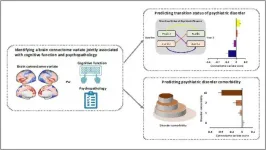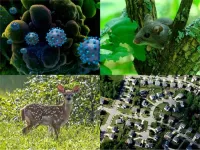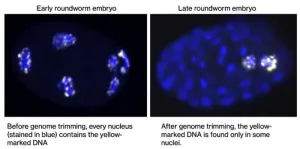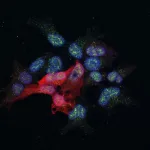(Press-News.org) Lasers are essential tools for observing, detecting, and measuring things in the natural world that we can’t see with the naked eye. But the ability to perform these tasks is often restricted by the need to use expensive and large instruments.
In a newly published cover-story paper in the journal Science, researcher Qiushi Guo demonstrates a novel approach for creating high-performance ultrafast lasers on nanophotonic chips. His work centers on miniaturizing mode-lock lasers — a unique laser that emits a train of ultrashort, coherent light pulses in femtosecond intervals, which is an astonishing quadrillionth of a second.
Ultrafast mode-locked lasers are indispensable to unlocking the secrets of the fastest timescales in nature, such as the making or breaking of molecular bonds during chemical reactions, or light propagation in a turbulent medium. The high-speed, pulse-peak intensity and broad-spectrum coverage of mode-locked lasers have also enabled numerous photonics technologies, including optical atomic clocks, biological imaging, and computers that use light to calculate and process data.
Unfortunately, state-of-the-art mode-locked lasers are currently expensive, power-demanding tabletop systems that are limited to laboratory use.
“Our goal is to revolutionize the field of ultrafast photonics by transforming large lab-based systems into chip-sized ones that can be mass produced and field deployed,” said Guo, a faculty member with the CUNY Advance Science Research Center’s Photonics Initiative and a physics professor at the CUNY Graduate Center. “Not only do we want to make things smaller, but we also want to ensure that these ultrafast chip-sized lasers deliver satisfactory performances. For example, we need enough pulse-peak intensity, preferably over 1 Watt, to create meaningful chip-scale systems.”
Realizing an effective mode-locked laser on a chip is not a straightforward process, however. Guo's research leverages an emerging material platform known as thin-film lithium niobate (TFLN). This material enables very efficient shaping and precise control of laser pulses by applying an external radio frequency electrical signal. In their experiments, Guo’s team uniquely combined the high laser gain of III-V semiconductors and the efficient pulse shaping capability of TFLN nanoscale photonic waveguides to demonstrate a laser that can emit a high output peak power of 0.5 Watt.
Beyond its compact size, the demonstrated mode-locked laser also exhibits many intriguing properties that are beyond reach by conventional ones, offering profound implications for future applications. For example, by adjusting the pump current of the laser, Guo was able to precisely tune the repetition frequencies of out pulses in a very wide range of 200 MHz. By employing the strong reconfigurability of the demonstrated laser, the research team hopes to enable chip-scale, frequency-stabilized comb sources, which are vital for precision sensing.
Guo’s team will need to address additional challenges to realize scalable, integrated, ultrafast photonic systems that can be translated for use in portable and handheld devices, but his lab has overcome a major obstacle with this current demonstration.
“This achievement paves the way for eventually using cell phones to diagnose eye diseases or analyzing food and environments for things like E. coli and dangerous viruses,” Guo said. “It could also enable futuristic chip-scale atomic clocks, which allows navigation when GPS is compromised or unavailable.”
More information, including a copy of the paper, can be found online at the Science press package at https://www.eurekalert.org/press/scipak/.
About the Graduate Center of The City University of New York
The CUNY Graduate Center is a leader in public graduate education devoted to enhancing the public good through pioneering research, serious learning, and reasoned debate. The Graduate Center offers ambitious students nearly 50 doctoral and master’s programs of the highest caliber, taught by top faculty from throughout CUNY — the nation’s largest urban public university. Through its nearly 40 centers, institutes, initiatives, and the Advanced Science Research Center, the Graduate Center influences public policy and discourse and shapes innovation. The Graduate Center’s extensive public programs make it a home for culture and conversation.
About the Advanced Science Research Center at the CUNY Graduate Center
The Advanced Science Research Center at the CUNY Graduate Center (CUNY ASRC) is a world-leading center of scientific excellence that elevates STEM inquiry and education at CUNY and beyond. The CUNY ASRC’s research initiatives span five distinctive, but broadly interconnected disciplines: nanoscience, photonics, neuroscience, structural biology, and environmental sciences. The center promotes a collaborative, interdisciplinary research culture where renowned and emerging scientists advance their discoveries using state-of-the-art equipment and cutting-edge core facilities.
END
Photonics team develops high-performance ultrafast lasers that fit on a fingertip
The new advance will enable pocket-sized devices that can perform detailed GPS-free precision navigation, medical imaging, food safety inspection and more
2023-11-09
ELSE PRESS RELEASES FROM THIS DATE:
Scientists flag conflicts of interest ahead of UN plastic and chemical talks
2023-11-09
An international group of 35 scientists is calling out conflicts of interest plaguing global plastic treaty negotiations and that have interfered with timely action on other health and environmental issues. They urge the implementation of strict guidelines to prevent the same problems from affecting the UN’s upcoming Science Policy Panel on chemicals. Their concerns and recommendations are outlined in a featured paper in the journal Environmental Science & Technology.
“From Big Tobacco to Big Oil, powerful industries use the same playbook to manufacture doubt and sow misinformation,” said co-author Bethanie ...
First-ever crowd-sourced small molecule discovery and a potent SARS-CoV-2 antiviral lead compound announced by COVID Moonshot Consortium
2023-11-09
The work of the COVID Moonshot Consortium is being published in the prestigious journal Science on 10 November, revealing their discovery of a potent SARS-CoV-2 antiviral lead compound. It also reflects on the success of its open science approach in launching a patent-free antiviral discovery program to rapidly develop a differentiated lead in response to a pandemic emergency. Open science discovery of potent noncovalent SARS-CoV-2 main protease inhibitors ) DOI 10.1126/science.abo7201.
The COVID Moonshot initiative ...
Cornell chemists image basic blocks of synthetic polymers
2023-11-09
ITHACA, N.Y. -- Synthetic polymers are everywhere in our society – from nylon and polyester clothing to Teflon cookware and epoxy glue. At the molecular level, these polymers’ molecules are made of long chains of monomer building blocks, the complexity of which increases functionality in many such materials.
In particular, copolymers, which consist of different types of monomers in the same chain, allow for fine-tuning of the material’s properties, said Peng Chen, the Peter J.W. Debye Professor of Chemistry in the College of Arts and Sciences (A&S). The monomer sequence plays a critical role in a material’s properties, but scientists until ...
Brain imaging identifies biomarkers of mental illness
2023-11-09
Philadelphia, November 9, 2023 – Research and treatment of psychiatric disorders are stymied by a lack of biomarkers – objective biological or physiological markers that can help diagnose, track, predict, and treat diseases. In a new study, researchers use a very large dataset to identify predictive brain imaging-based biomarkers of mental illness in adolescents. The work appears in Biological Psychiatry, published by Elsevier.
Traditionally, psychiatric disorders such as depression have been diagnosed based on symptoms according to subjective assessments. The identification of biomarkers to aid in diagnosis and treatment selection would greatly advance treatments.
In ...
Cary Institute partners on $3M USDA-funded study on COVID-19 variants that could emerge from wildlife
2023-11-09
Many wild animals can carry COVID-19, including those that live among us, such as deer mice, red foxes, white-tailed deer, and more. These species may act as reservoirs, offering new opportunities for the virus to mutate and spill back into people. The omicron variant, for example, is thought to have emerged from mice.
With $3 million in federal grant funding, a new five-year research project will bring together virology, disease ecology, and artificial intelligence to better understand how SARS-CoV-2 (the virus that causes COVID-19) behaves ...
The enigma of embryonic development: How certain animals trim their genomes
2023-11-09
New research is underway to decipher a fascinating biological puzzle—how some animals can naturally discard more than half of their genetic information during embryonic development.
This radical natural phenomenon has captivated scientists for over 130 years, presenting a tantalizing question in the field of developmental biology and genetics.
Equipped with the latest in genetic engineering tools, the team at The University of Warwick is working to dissect the mechanisms behind this selective genomic editing. By uncovering the processes that allow some nematode worms to abandon up to ...
New URI lab developing adaptive technology, secures National Science Foundation grant
2023-11-09
New URI lab developing adaptive technology, secures National Science Foundation grant
Reza Abiri and Yalda Shahriari receive National Science Foundation award totaling $460,000 for work to improve stroke patient rehabilitation
Passing by Reza Abiri’s office at the University of Rhode Island, one might suspect him of nursing a serious coffee habit. A colorful collection of various mugs and cups dot his office, and though he is friendly enough to likely welcome any visitors stopping by to chat, the cups serve a larger purpose.
Abiri and Yalda Shahriari, professors in ...
MD Anderson announces Institute for Data Science in Oncology to advance mission to end cancer
2023-11-09
HOUSTON ― The University of Texas MD Anderson Cancer Center today announced the launch of its Institute for Data Science in Oncology (IDSO), which integrates the most advanced computational and data science approaches with the institution’s extensive scientific and clinical expertise to significantly improve patient’s lives by transforming cancer care and research.
Bringing top data scientists from a variety of fields together with clinicians and cancer scientists, the institute builds on MD Anderson’s culture of collaboration and connectivity to tackle the field’s most pressing needs in new and innovative ways. IDSO’s efforts have been catalyzed by philanthropic ...
Researchers decipher the mechanism by which the MAF protein promotes breast cancer metastasis
2023-11-09
The MAF protein interacts with the estrogen receptor, alters its function, and promotes the spread of cancer.
The KDM1A enzyme plays a fundamental role in the epigenetic remodelling that facilitates the function of pro-metastatic genes.
The work carried out in Dr. Roger Gomis Lab at IRB Barcelona has been published in the journal Nature Cell Biology.
Barcelona, 9 November 2023 – Breast cancer is the most common form of cancer among women, with more than 2 million new cases diagnosed each year. In cases where the tumour remains localised in the breast, survival rates are remarkably high, ...
New research: Fivefold increase in the melting of Greenland's glaciers over the last 20 years
2023-11-09
New research: Fivefold increase in the melting of Greenland's glaciers over the last 20 years
In the largest survey of its kind ever conducted, using both satellite imagery and old aerial photos from the Danish National Archives, researchers from the University of Copenhagen firmly establish that Greenland’s glaciers are melting at an unprecedented pace. Melting has increased fivefold in the past 20 years. The study eliminates any lingering doubts about the impact of climate change on Greenland's more than 20,000 glaciers.
Based on the most comprehensive monitoring ...
LAST 30 PRESS RELEASES:
University of Oklahoma researcher awarded funding to pursue AI-powered material design
Exploring how the visual system recovers following injury
Support for parents with infants at pediatric check-ups leads to better reading and math skills in elementary school
Kids’ behavioral health is a growing share of family health costs
Day & night: Cancer disrupts the brain’s natural rhythm
COVID-19 vaccination significantly reduces risk to pregnant women and baby
The role of vaccination in maternal and perinatal outcomes associated with COVID-19 in pregnancy
Mayo Clinic smartwatch system helps parents shorten and defuse children's severe tantrums early
Behavioral health spending spikes to 40% of all children’s health expenditures, nearly doubling in a decade
Digital cognitive behavioral treatment for generalized anxiety disorder
Expenditures for pediatric behavioral health care over time and estimated family financial burden
Air conditioning in nursing homes and mortality during extreme heat
The Alps to lose a record number of glaciers in the next decade
What makes a good proton conductor?
New science reporting guide published for journalists in Bulgaria
New international study reveals major survival gaps among children with cancer
New science reporting guide published for journalists in Turkey
Scientists develop a smarter mRNA therapy that knows which cells to target
Neuroanatomy-informed brain–machine hybrid intelligence for robust acoustic target detection
Eight SwRI hydrogen projects funded by ENERGYWERX
The Lundquist Institute and its start-up company Vitalex Biosciences Announces Strategic Advancement of Second-Generation fungal Vaccine VXV-01 through Phase 1 Trials under $40 Million Competitive Con
Fine particles in pollution are associated with early signs of autoimmune disease
Review article | Towards a Global Ground-Based Earth Observatory (GGBEO): Leveraging existing systems and networks
Penn and UMich create world’s smallest programmable, autonomous robots
Cleveland researchers launch first major study to address ‘hidden performance killer’ in athletes
To connect across politics, try saying what you oppose
Modulating key interaction prevents virus from entering cells
Project explores barriers to NHS career progression facing international medical graduates
Jeonbuk National University researchers explore the impact of different seasonings on the flavor perception of Doenjang soup
Two Keck Medicine of USC Hospitals named Leapfrog Top Teaching Hospitals
[Press-News.org] Photonics team develops high-performance ultrafast lasers that fit on a fingertipThe new advance will enable pocket-sized devices that can perform detailed GPS-free precision navigation, medical imaging, food safety inspection and more










